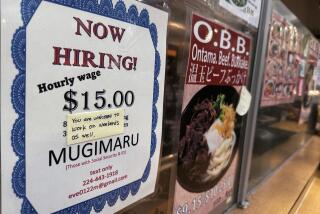Consumer prices fall; jobless claims rise again
Washington — The government reported fresh signs of a weakening job market, even as consumers got some relief from falling energy prices that led to a sharp drop in inflation in May.
The combination of rising jobless claims and easing consumer prices should give the Federal Reserve more reason to inject new monetary stimulus into the economy, although few analysts expect the central bank to pull the trigger at its next policy meeting Tuesday and Wednesday.
On Thursday, the Labor Department said new filings for jobless benefits rose by 8,000 last week to a seasonally adjusted 386,000 claims. It was the fifth increase in the last six weeks, consistent with the spring slowdown in job growth seen in the monthly employment reports.
Analysts say the deepening financial problems in Europe and the economic uncertainties at home are weighing on employers. The less-volatile four-week moving average of new jobless claims rose to 382,000, which is the highest level since April. Jobless claims are an indication of layoffs.
Separately, the Labor Department said the consumer price index dropped a larger-than-expected 0.3% in May -- the first decline in the month-to-month change in the last year.
The monthly decline in the inflation index was mostly because of a steep 6.8% fall in average gasoline prices.
“This is exactly what the Fed has been predicting, that higher gas prices would be transitory, and opens a door to additional easing if necessary,” said Diane Swonk, chief economist at Mesirow Financial in Chicago. “We welcome lower prices at the pump,” she said in a note to clients, “but not the reason we have them, which is economic weakness and anxiety about the future.”
For all goods and services, the 12-month change in the consumer price index fell to 1.7% in May from 2.3% in April. That was the lowest rate since early 2011.
Excluding the volatile energy and food items, the so-called core inflation rate held steady in May at 2.3% for the third straight month, as prices for used cars, clothes and medical services bounced higher.
Analysts expect core inflation to slide lower to the Fed’s target of 2%, thus setting the stage for further monetary easing by the Fed.
“The Federal Reserve has been quiet about its intentions at next week’s meeting, but inflation hawks will have less ground to stand on given the recent weakness in consumer prices,” said James Bohnaker ofMoody’sAnalytics in West Chester, Pa.
RELATED:
Fed Chairman Ben Bernanke warns of ‘fiscal cliff’ risks
Average U.S. family’s wealth plunged 40% in recession, Fed says
California’s gas prices continue to fall, as rest of U.S. slows
More to Read
Inside the business of entertainment
The Wide Shot brings you news, analysis and insights on everything from streaming wars to production — and what it all means for the future.
You may occasionally receive promotional content from the Los Angeles Times.











